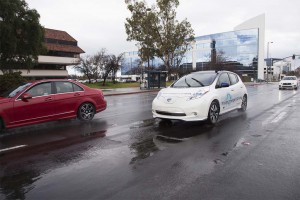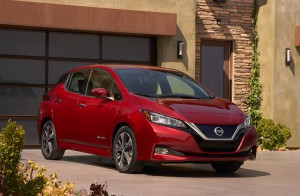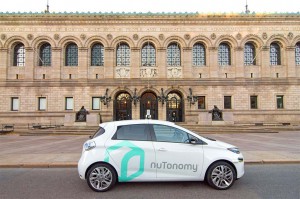One of the first automakers to commit to developing autonomous vehicle technology, Nissan plans to begin field-testing its first robocabs in Japan next year, part of an expanding development program aimed at putting fully autonomous vehicles into production by 2022.
The pilot program, pairing Nissan with technology development firm DeNA, will operate near the Japanese automaker’s headquarters in Yokohama. It will be the latest in a fast-growing series of self-driving ride-share programs, including one started by Google spin-off Waymo this year. Lyft is launching its own field test in Boston. And Nissan’s alliance partner, Renault has been testing similar technology in France.
Nissan last week revealed it intends to have its first fully autonomous vehicle in production sometime during the 2022 calendar year. But the carmaker plans to introduce a series of increasingly sophisticated, semi-autonomous technologies before then, starting with the ProPilot system debuting on the 2018 Nissan Leaf battery-electric vehicle.
(Lyft to launch driverless ride-share pilot in Boston. Click Here for more.)
Virtually every major automaker – as well as a number of start-ups and tech firms – is now working on autonomous vehicle technology. New rules being proposed in Congress would make it easier for those companies to run tests on public roads. But a number of pilot programs already are underway in the U.S. and abroad.
Nissan is set to become the latest with the Yokohama field test. The project will run for two weeks in March in part of downtown Yokohama and it will rely on two specially modified Leaf battery-electric vehicles.
As with Waymo’s program, participants would sign up and then ride for free. But the Japanese pilot would limit where volunteers could get on and off to designated pickup points, rather than letting them summon a ride as they might with a conventional cab or ride-sharing service.
An operator will be assigned to the two Nissan robocabs, ready to take control in an emergency. Nissan has not set a timetable for testing a completely driverless vehicle. Waymo has also been using backup operators, but it now plans to begin testing fully driverless models, as well.
(Click Here for more about GM’s driverless ride-sharing plans.)
Japan’s second-largest automaker was among the first to lay out plans to bring autonomous technology to market. At an event in California in August 2013, former Nissan global product chief Andy Palmer declared, “We will be ready to bring a readily affordable, fully affordable autonomous vehicle to the market by 2020.”
Last week, the automaker said it would not get there until 2022. Whether its timetable has actually slipped, however, is a matter of interpretation. The industry trade group SAE has defined various levels of autonomy, starting with driver-assistance features like active cruise control up to Level 5 systems that can operate without a human anywhere and any time.
For 2018, Nissan is launching ProPilot on a number of models, including the second-generation Leaf. The system is capable of not only maintaining a vehicle’s position in traffic but also holding its position in a lane – though the driver is still required to maintain at least a light grip on the steering wheel.
An even more sophisticated Nissan system, likely capable of hands-free operation – and similar to the new Cadillac Super Cruise – is expected by 2019. And several sources tell TheDetroitBureau.com that what some might consider a true, autonomous vehicle would join the Nissan line-up by 2020. It would add the ability to operate on urban roads, not just well-marked, limited-access highways. But a driver/operator would still need to sit behind the wheel, ready to take over if needed.
The carmaker is expecting to reach Level 5 by 2022. Such a vehicle would be able to operate anywhere without a driver and could even function on unmarked roads or in bad weather conditions.
Nissan is not saying where it will market such a vehicle, however the technology needed to get there is still expected to be quite costly. That’s why Ford and General Motors, among others, initially plan to target fleet users with their first Level 5 systems. These could include ride-sharing services, such as Uber or Lyft, as well as delivery fleets.
(Chinese ride-sharing giant Didi eyeing opportunities in North America. Click Here for the story.)



